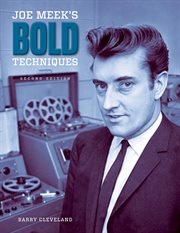Details
PUBLISHED
DESCRIPTION
1 online resource
ISBN/ISSN
LANGUAGE
NOTES
Joe Meek's Bold Techniques updates the 2001 print edition, and features a new Introduction, an additional chapter, and a newly restored and remastered version of Meek's legendary 1959 stereo album about life on the Moon, I Hear a New World. Joe Meek was an iconoclastic British recording innovator who was also, among other things, a paranoid schizophrenic homosexual speed freak who believed he was in psychic communication with Buddy Holly and who murdered his landlady with a shotgun before shooting himself in 1967. Cleveland, however, takes an industry perspective, focusing primarily on Meek's 12-year professional recording career, rather than his personal life. Joe Meek's best-known recording, "Telstar," topped the charts worldwide in 1962, and he engineered and produced dozens of U.K. hits. The extensive roster of fine musicians that graced Meek's recordings includes guitarists Ritchie Blackmore, Steve Howe, and Jimmy Page (Page credits Meek as having been a major influence on his own production). Joe Meek was also responsible for many recording "firsts," at least in the U.K. For example, he was
%x;
%x; - One of the first to experiment professionally with sound-on-sound overdubbing techniques (1951)
%x; - The first to put microphones directly in front of and sometimes inside sound sources (1954)
%x; - The first to intentionally overload preamplifier inputs and print "hot" signals to tape (1954)
%x; - The first to use compressors and limiters aggressively in creative rather than corrective applications (1954)
%x; - The first to build a compact spring reverb unit (1957)
%x; - The first to "flange" sounds using two synchronized tape recorders (1958)
%x; - The first to employ tape loops on commercial recordings (1959)
Mode of access: World Wide Web







